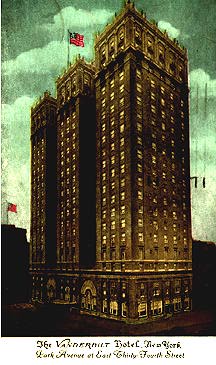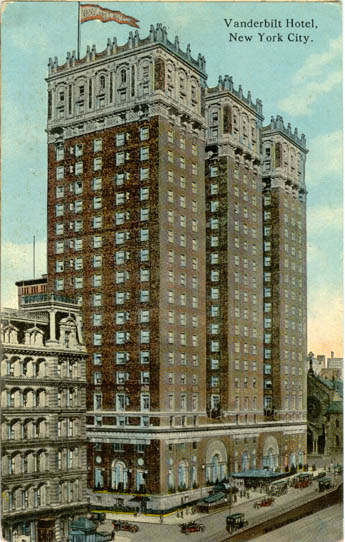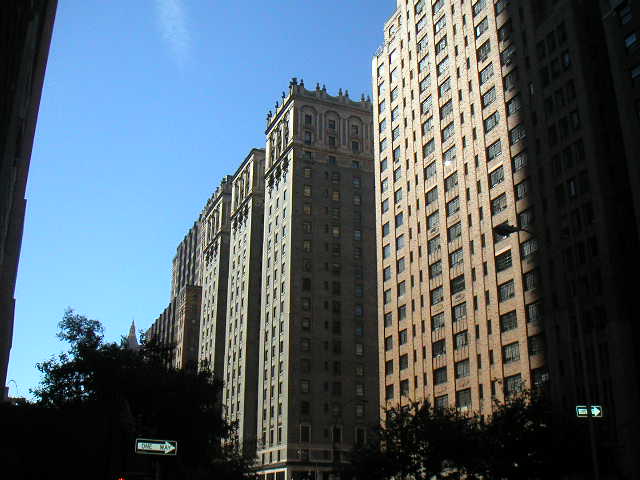 |
New York
Architecture Images- Midtown Vanderbilt Hotel |
|
architect |
Warren & Wetmore |
|
location |
4 Park Avenue, between E33 and E34. |
|
date |
1913 |
|
style |
Historicist Skyscraper |
|
construction |
|
|
type |
Hotel |
|
|
  |
|
images |
|
|
|
 |
|
From its 1913 completion until it was
converted to apartments in 1965, this was the Vanderbilt Hotel, one of
the city's most fashionable in the early 20th Century. Singer Enrico
Caruso lived here in 1920 and 1921, his last U.S. home.
Underneath this building is Wolfgang's Steakhouse, run by the Wolfgang Zwiener, who was the legendary headwaiter at Peter Luger's for 40 years (though he got his start at Luchow's). The space, recently called Vanderbilt Station, was famous as the Della Robbia Bar, aka The Crypt. The vaulted Gaustavino ceiling is the big claim to fame. The rumor that this used to be Commodore Vanderbilt's secret private subway station seems not to be true. |
|
|
Streetscapes/The Former Vanderbilt Hotel, 34th
Street and Park Avenue; It Was a Showcase for Terra Cotta. Much
Remains. By CHRISTOPHER GRAY Published: March 9, 2003, Sunday THE delicate Adam-style terra cotta decoration of the former Vanderbilt Hotel at 34th Street and Park Avenue received rough treatment in the 1960's -- the lower facade was stripped away and some statues on the parapet were removed. But much terra cotta remained, and it was repaired in a facade alteration that ended last year. Part of the building's interior is a landmark, but the exterior is unprotected, and the future of what was once a widely praised work of architecture raises interesting questions for preservationists. Alfred Gwynne Vanderbilt, the great-grandson of Commodore Cornelius Vanderbilt, the railroad magnate, built the hotel in 1912. Heir to millions, Alfred Vanderbilt had grown up in the palatial family house at 57th Street and Fifth Avenue, where Bergdorf-Goodman now stands. He built his new hotel primarily for permanent residents, to accommodate a new generation of the rich who sought freedom from household cares -- including himself. He took two floors at the top of the 22-story building. The architects Warren & Wetmore (co-designers of Grand Central Terminal, also build for the Vanderbilt family) designed one of the most widely admired buildings of the period, a slim, high rectangular mass of variegated steel-gray brick and cream-colored terra cotta. The building was in fact a showcase for terra cotta. The ground floor boasted huge Adam-style windows with delicate fluted fans; the upper portions had a rich, frothy network of terra-cotta colonettes, helmets, lions' heads and lozenge shapes, all set against a crisscross brick pattern. The roof omitted the usual projecting cornice (by then criticized for casting shadows) for a parapet festooned with lacy decoration with classical heads. To add a whimsical touch, the curving parapet at the top was outlined in electric lights. A critic for the magazine Architecture & Building loved the gray brick for its complex undercurrent of ''hidden and indescribable golden browns and blues,'' calling it ''a sight worth crossing a continent to see.'' Susan Tunick, head of the Friends of Terra Cotta, says that the material was the work of the New Jersey Terra Cotta Company. The emphasis on permanent residents in the Vanderbilt freed Warren & Wetmore from the usual constraints of hotel design. Since the hotel did not require a large ballroom, the architects were able to make the first floor one huge lounge, with high vaulted ceilings. A portion of the ground floor was set up as a dining room, but the much larger grill room and bar -- several fantastical arched spaces covered in polychrome terra cotta -- were on the basement floor. An unidentified assistant manager told The New York Times that the hotel's public spaces could be more homelike than usual, adding that ''it has been our aim in decorating the house to eliminate the red and gold idea in hotel decoration.'' Instead of the usual heavy velvet and gilt ornament, the interiors used a chaste mix of simple stone surfaces with carved stone friezes on the upper walls. Amenities like pneumatic tubes that could deliver messages from bottom to top in seven seconds led the magazine American Architect to praise the Vanderbilt as ''a memory of the land of ancient courtesies'' in an increasingly hectic age. Some idea of the character of the Vanderbilt's guests is given in a 1913 account in The Times. An unidentified family left the hotel unexpectedly, and their French maid, identified only as Felice, hurriedly packed the trunk dedicated to her mistress's furs. In her rush, the maid closed the lid on the family dog, a tiny Pomeranian named Papillon. The dog was found only when the hotel's elevator operator became alarmed by moaning from the trunk. THE 1915 census included residents like Duncan Roberts, 62, president of the United States Express Company, a parcel-delivery concern. The census, recorded in June, did not list Alfred Gwynne Vanderbilt. He had died a hero in May after giving his life jacket to a woman on the Lusitania, which sank after being torpedoed by the Germans off Ireland. Vanderbilt's apartment was taken over by the Women's City Club, whose literary and politically active members came to hear guests like George Kirchwey, warden of Sing Sing prison, lecture on social issues. The renowned tenor Enrico Caruso later took the suite. On. Jan. 1, 1921, ill with pleurisy, he was attended by six physicians, who were especially concerned that the noise from New Year's revelers was keeping him awake, even though they were far below. Caruso died in Naples that August. The Vanderbilt heirs sold the building in 1925. In 1967, the hotel was converted to apartments on the upper floors, with offices on the lower six. The bar adjacent to the terra cotta grill complex survived fairly intact and is now the restaurant Vanderbilt Station. At the time, one plan was to strip the building to its steel frame. But only the lower floors were modernized, by the architects Schuman, Lichtenstein & Claman. The lower facade was stripped away, replaced with a modern facade of travertine. A dozen or more of the terra cotta statues on the parapet were removed to improve the view from several new penthouse apartments. Peter Claman, who worked on the project, says that he took a number of the terra cotta busts for his own use. Others were given to an art dealer, and two wound up at the Brooklyn Museum Sculpture Garden. In 1994 the surviving portion the terra cotta bar was designated an interior landmark. But a 1985 survey by the Landmarks Preservation Commission said that the exterior had less architectural significance, perhaps because of the modernization of the lower section. Last year the building's owner, Four Park Avenue Associates, completed a $700,000 facade alteration. The architects, Israel Berger & Associates, did the normal repointing and limited patching of what Mr. Berger describes as ''ordinary deterioration.'' Stanford Chan, an architect in the firm, said that the terra cotta was in generally good condition, including the remaining projecting busts ringing the parapet, and that the repair is more or less invisible from the street. There is nothing to prevent a future owner from stripping the building's exterior, although such work has declined in recent decades. And the question of regulating the building creates a quandary for preservationists. Mosette Broderick, an architectural historian and professor at New York University, said that the 1967 alteration fell within the minimum requirement that a building be 30 years old to receive landmark designation, but she added that she was not sure that the building as altered merited protection. Norval White, an architect and the co-author of ''The A.I.A. Guide to New York City'' (Crown, 2000) said that ''the ravages to the ground floor have taken it off the preservation list.'' But Jeffrey Kroessler, the president of the Queensborough Preservation League, who is also active in citywide preservation issues, said: ''All manner of classical and Victorian buildings were remuddled in the 50's and 60's, but that does not entirely negate their historic character nor remove an obligation to maintain the historic elements. And it's reversible.'' Published: 03 - 09 - 2003 , Late Edition - Final , Section 11 , Column 1 , Page 7 Copyright New York Times. |
|